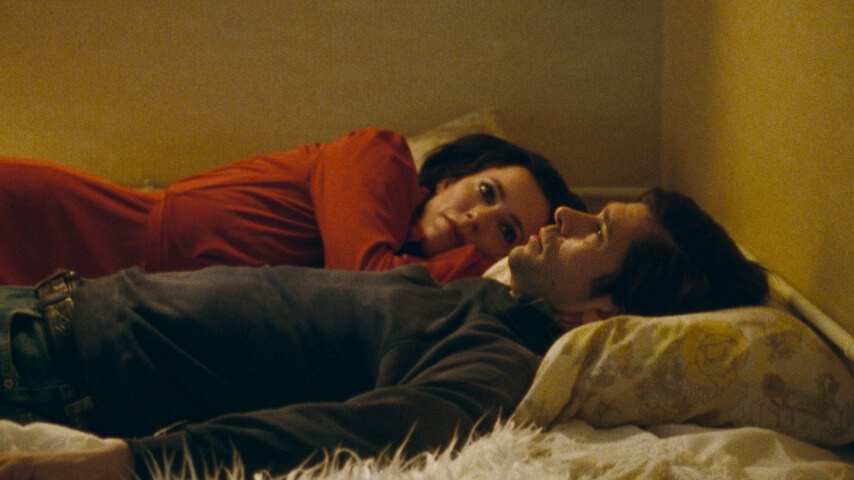There’s a perverse intrigue in reading someone else’s diary. The daily thoughts and routines of another prove infinitely fertile for reflection: In what ways are they more well-adjusted, unexpectedly banal, or stark raving mad compared to ourselves? Through relating or refracting similarities and differences, a broader understanding of our own personhood can be achieved while also fostering an appreciation (or, depending on how unhinged the content, newfound disgust) for the idiosyncratic interiority of a fellow human being. While not a straightforward diary entry, the daily activities, anecdotes, and musings of a cultural icon are just as scintillating—and almost as intrusive to behold—in Peter Hujar’s Day.
Indie stalwart Ira Sachs (Passages) focuses on the titular New York City photographer (Ben Whishaw) as he recounts a day in his life to writer and close friend Linda Rosenkratz (a fine-tuned Rebecca Hall), herself an established art world luminary. It is December 19, 1974 when Rosenkrantz invites Hujar to her impeccably curated apartment on 94th Street in Manhattan. The purpose of this specific encounter is for Hujar to pore over every detail (nothing is too insignificant, meaning that stray ruminations abound) of what he did the day prior, which Rosenkrantz would record on tape and then transcribe. The aim was to publish a book containing a series of these “day in the life” artistic portraits, but that never quite manifested.
In fact, Sachs’ film wouldn’t exist if this very transcript wasn’t rediscovered and subsequently published as Peter Hujar’s Day in 2021. Yet when he gave his rambling summary of what occurred to him on December 18, Hujar himself was hardly considered on the same level of many of his contemporaries, among them Andy Warhol and Robert Mapplethorpe (David Wojnarowicz would also become his protégé some years later in the early ’80s). He was a struggling artist, who had previously attained a Fulbright scholarship and commercial photography gigs before deciding to solely pursue his own projects. John Waters, Susan Sontag, Fran Liebowitz, and William S. Burroughs all posed for him, but it wasn’t until after Hujar’s AIDS-related death in 1987 that he began to accrue widespread acclaim—an ironic artistic cliché for a true visionary.
Upon the publication of Peter Hujar’s Day, fellow subcultural photographer Nan Goldin wrote: “Read it and weep if you didn’t know him. Or read it and weep if you did that we lost him.” The same can be said of Sachs’ film. Though the previously mentioned 20th century cultural icons of gay New York are perhaps more recognizable, this film intimately aligns its audience with his process, personality, and pesky vices through Whishaw’s indelible performance—which is among his best, if only for the intense attention to the artist’s New Jersey-bred, NYC-inflected accent. No matter how familiar you might be with Hujar’s singular oeuvre, Whishaw will endear you to him as if you’re the one he’s ranting at, blowing cigarette smoke in the direction of, or, sometimes, just simply sitting in silence with.
This is where Hall’s performance comes perfectly into play. Her own accent is equally calculated, here with more of a native Bronx intonation. While Rosenkrantz is, by design, not meant to hijack the conversation, the warmth between the two is irrefutable. Sachs choreographs their movements on a speculative basis—the only thing unaltered here is the transcript; all production and costume design choices are “a fiction”—but the way they move about the apartment feels intuitive. Hours pass, natural lighting changes, and their impulses bring them to sit and stand in different spots. The film’s truly breathtaking scene happens when the duo venture to the building’s roof. As they look out onto a stretch of Manhattan skyline, it actually appears to be 1974. A chaotic, almost analog hum, far-off smokestacks, and classic architecture dominate the moment. Though it was shot on location, it’s heartening to feel that a New York once considered bygone—where affordable rent lent itself to an impecunious yet inspired artistic class—could be conjured anew.
The finer plot points, if you can call them that, of Peter Hujar’s Day aren’t quite the point, and there’s certainly no use recounting them in any granular sense here. Yes, the narrative cherry on top occurs when Hujar chronicles his photographing of Allen Ginsberg for The New York Times, an assignment he found challenging for reasons that are best experienced blind. Just know that for a day arbitrarily chosen by Rosenkrantz, it certainly yielded an incredible topic of conversation. But the little things, the random asides and minor revelations, are just as powerful as the star-studded namedrops during this extensive conversation. For one, Hujar doesn’t seem to eat any vegetables whatsoever, an alarming admission for a 39-year-old. He also quips about money he’s owed on a freelance basis and reveals his preference for sleep-ins and frequent naps. These intimate disclosures would not have been possible had a friendly face not been holding the microphone and pressing play; there’s a universality to having someone like this in his life, someone for whom no thought in his head is too weird, ugly, or unnecessary to divulge.
Thus is the true beauty of Peter Hujar’s Day, though Alex Ashe’s lush, era-appropriate film cinematography comes in close second. Few could emulate the striking incisiveness of Hujar’s artwork, but his sense of self will surely resonate with many. Who among us couldn’t eat more vegetables, smoke fewer cigarettes, or generally demand better treatment for ourselves and our passions? The variables might change, but the sentiment stays the same: The unvarnished presentation of our individuality is what makes us all the more interesting. Maybe our diaries shouldn’t be hidden away, but rather placed in prominent spots in our households.
Director: Ira Sachs
Writer: Ira Sachs
Starring: Ben Whishaw, Rebecca Hall
Release Date: November 7, 2025

